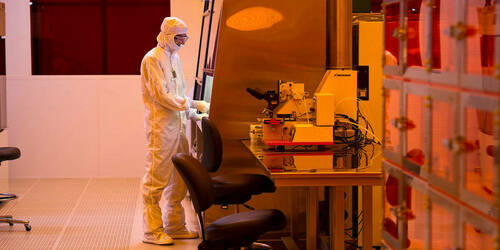
While the undefeated Fighting Irish and the Ohio State Buckeyes will meet as competitors Saturday (Sept. 23) at Notre Dame Stadium, the two universities have a long history of collaborating off the field to advance research in semiconductor and microelectronics, business and economics.
Semiconductors and microelectronics
Notre Dame is one of 11 founding members of the Midwest Semiconductor Network, led by Ohio State University, which aims to support the development of semiconductor nanofabrication facilities in the Midwest as well as the broader, national efforts to promote U.S. leadership in semiconductors and microelectronics. Alan Seabaugh, the Frank M. Freimann Professor of Electrical Engineering and director of Notre Dame Nanoscience and Technology (NDnano) has served on the network’s steering committee, which also has a focus on designing the curriculum needed to prepare a skilled workforce and create opportunities for experiential learning.
Learn about NDnano here.
Learn more about the Midwest Semiconductor Network here.
Read about “The Chip Makers” here.
Business and Economics
“Lyft” vs. “Lift.” What’s in a name? A lot, actually, when it comes to brand names. John Costello, assistant professor of marketing at Notre Dame’s Mendoza College of Business, and Jesse Walker and Rebecca Walker Reczek at Ohio State University studied how unconventionally spelled brand names may influence positive consumer perceptions. Their research, published in the Journal of Marketing, included 3,000 participants and eight experimental studies, measuring real and incentive-compatible consumption behavior.
Read more about their results here.
‘Deaths of despair’
Daniel Hungerman, professor of economics at Notre Dame, and Tamar Oostrom at Ohio State University, along with Tyler Giles at Wellesley College, studied links between a decline in religious participation and death rates from poisonings, suicides and alcoholic liver disease otherwise known as “deaths of despair.” The study, issued as a working paper in the National Bureau of Economic Research, highlighted how changes in religious participation can have large consequences for the health and well-being of middle-aged, white individuals. “It’s pretty unusual for an advanced country like America to see people start dying sooner, at a younger age,” Hungerman said. “And what we found is there is a direct correlation between the effects of religious practice and these mortality rates from alcoholism, suicide and overdose.”
Read more about the study’s findings here.
Contact: Jessica Sieff, associate director, media relations, 574-631-3933, jsieff@nd.edu